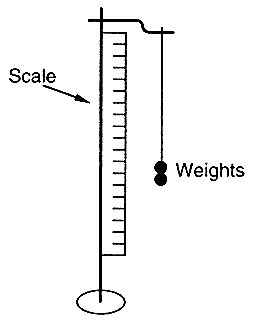 |
 |
|
|
|
|
Grades 9-12 Performance Task Description:Students design and carry out an experiment testing Hooke's Law, which describes the relationship between the force applied to a spring and its elongation (stretch). This task assesses students' abilities to design an experiment (with hypothesis, expected effect, and description of independent and dependent variables, procedures for investigation, and plan for organizing observations), collect consistent and accurate data, complete a data table, create a graph with plotted points, calculate force and stretch, and make conclusions consistent with scientific principles and identifying sources of error. This task is designed to take students approximately 80 minutes to complete - 30 minutes for Part A (designing the experiment) and 50 minutes for Part B (completing the experiment). Overall Task Content Area:
Specific Knowledge Areas:
Performance Expectations:
National Science Education Standards:12 A SI 1: Abilities necessary to do scientific inquiry:
Grades 9-12 1.3 Use technology and mathematics to improve investigations and communications. A variety of technologies, such as hand tools, measuring instruments, and calculators, should be an integral component of scientific investigations. The use of computers for the collection, analysis, and display of data is also a part of this standard. Mathematics plays an essential role in all aspects of an inquiry. For example, measurement is used for posing questions, formulas are used for developing explanations, and charts and graphs are used for communicating results. 1.4 Formulate and revise scientific explanations and models using logic and evidence. Student inquiries should culminate in formulating an explanation or model. Models should be physical, conceptual, and mathematical. In the process of answering the questions, the students should engage in discussions and arguments that result in the revision of their explanations. These discussions should be based on scientific knowledge, the use of logic, and evidence from their investigation. 12 B PS 4: Motions and forces: Grades 9-12 (Use the "hot" link on the PALS home page to check the full text of related National Science Education Standards, if desired.) National Council of Teachers of Mathematics:NO3: Compute fluently and make reasonable
estimates: AL1: Understand patterns, relations and
functions: AL2: Represent and analyze mathematical
situations and structures using algebraic symbols: AL4: Analyze change in various contexts:
DAP1: Formulate questions that can be addressed
with data and collect, organize, and display relevant data to answer
them: PS1: Build new mathematical knowledge through
problem solving: RP3: Develop and evaluate mathematical arguments
and proofs: COM4: Use the language of mathematics to
express mathematical ideas precisely: REP2: Select, apply, and translate among mathematical
representations to solve problems: General Instructions to the Teacher:This task is designed to take students approximately 80 minutes to complete. Students will be working individually during this exercise. Students should be ready to work as soon as the period begins. The materials should be set out at each lab station, if possible. A central supply area, if needed, should be easily accessible. All supplies should be clearly labeled. Materials for "Hooke's Law":
Note: The objective is to have students determine whether their spring will stretch 0.3m when 15N is attached. They should not have 15N available to make this determination.
Advance Preparation:None Safety:Be careful. Teachers and students should always exercise appropriate safety precautions and utilize appropriate laboratory safety procedures and equipment when working on science performance tasks. Extensions/Modifications:None
|
